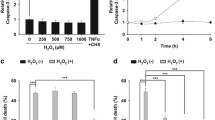Abstract
Poly(ADP-ribose) polymerase-1 (PARP-1) mediates neuronal cell death in a variety of pathological conditions involving severe DNA damage. Poly(ADP-ribose) (PAR) polymer is a product synthesized by PARP-1. Previous studies suggest that PAR polymer heralds mitochondrial apoptosis-inducing factor (AIF) release and thereby, signals neuronal cell death. However, the details of the effects of PAR polymer on mitochondria remain to be elucidated. Here we report the effects of PAR polymer on mitochondria in cells in situ and isolated brain mitochondria in vitro. We found that PAR polymer causes depolarization of mitochondrial membrane potential and opening of the mitochondrial permeability transition pore early after injury. Furthermore, PAR polymer specifically induces AIF release, but not cytochrome c from isolated brain mitochondria. These data suggest PAR polymer as an endogenous mitochondrial toxin and will further our understanding of the PARP-1-dependent neuronal cell death paradigm.
Similar content being viewed by others
References
Andrabi, S.A., Kim, N.S., Yu, S.W., Wang, H., Koh, D.W., Sasaki, M., Klaus, J.A., Otsuka, T., Zhang, Z., Koehler, R.C., et al. (2006). Poly(ADP-ribose) (PAR) polymer is a death signal. Proc. Natl. Acad. Sci. USA 103, 18308–18313.
Andrabi, S.A., Kang, H.C., Haince, J.F., Lee, Y.I., Zhang, J., Chi, Z., West, A.B., Koehler, R.C., Poirier, G.G., Dawson, T.M., et al. (2011). Iduna protects the brain from glutamate excitotoxicity and stroke by interfering with poly(ADP-ribose) polymer-induced cell death. Nat. Med. 17, 692–699.
Azarashvili, T., Grachev, D., Krestinina, O., Evtodienko, Y., Yurkov, I., Papadopoulos, V., and Reiser, G. (2007). The peripheral-type benzodiazepine receptor is involved in control of Ca2+-induced permeability transition pore opening in rat brain mitochondria. Cell Calcium 42, 27–39.
Brown, M.R., Sullivan, P.G., and Geddes, J.W. (2006). Synaptic mitochondria are more susceptible to Ca2+-overload than nonsynaptic mitochondria. J. Biol. Chem. 281, 11658–11668.
Diefenbach, J., and Burkle, A. (2005). Introduction to poly(ADPribose) metabolism. Cell. Mol. Life. Sci. 62, 721–730.
Ehrenberg, B., Montana, V., Wei, M.D., Wuskell, J.P., and Loew, L. M. (1988). Membrane potential can be determined in individual cells from the nernstian distribution of cationic dyes. Biophys. J. 53, 785–794.
Farkas, D.L., Wei, M.D., Febbroriello, P., Carson, J.H., and Loew, L.M. (1989). Simultaneous imaging of cell and mitochondrial membrane potentials. Biophys. J. 56, 1053–1069.
Fulda, S., Galluzzi, L., and Kroemer, G. (2010). Targeting mitochondria for cancer therapy. Nat. Rev. Drug. Discov. 9, 447–464.
Green, D.R., and Reed, J.C. (1998). Mitochondria and apoptosis. Science 281, 1309–1312.
Herceg, Z., and Wang, Z.Q. (1999). Failure of poly(ADP-ribose) polymerase cleavage by caspases leads to induction of necrosis and enhanced apoptosis. Mol. Cell. Biol. 19, 5124–5133.
Kim, J.S., Qian, T., and Lemasters, J.J. (2003). Mitochondrial permeability transition in the switch from necrotic to apoptotic cell death in ischemic rat hepatocytes. Gastroenterology 124, 494–503.
Kroemer, G., Galluzzi, L., Vandenabeele, P., Abrams, J., Alnemri, E.S., Baehrecke, E.H., Blagosklonny, M.V., El-Deiry, W.S., Golstein, P., Green, D.R., et al. (2009). Classification of cell death: recommendations of the Nomenclature Committee on Cell Death 2009. Cell. Death. Differ. 16, 3–11.
Luo, X., and Kraus, W.L. (2012). On PAR with PARP: cellular stress signaling through poly (ADP-ribose) and PARP-1. Genes Dev. 26, 417–432.
Petronilli, V., Miotto, G., Canton, M., Colonna, R., Bernardi, P., and Di Lisa, F. (1998). Imaging the mitochondrial permeability transition pore in intact cells. BioFactors 8, 263–272.
Polster, B.M., Basanez, G., Etxebarria, A., Hardwick, J.M., and Nicholls, D.G. (2005). Calpain I induces cleavage and release of apoptosis-inducing factor from isolated mitochondria. J. Biol. Chem. 280, 6447–6454.
Reers, M., Smith, T.W., and Chen, L.B. (1991). J-aggregate formation of a carbocyanine as a quantitative fluorescent indicator of membrane potential. Biochemistry 30, 4480–4486.
Sims, N.R., and Anderson, M.F. (2008). Isolation of mitochondria from rat brain using Percoll density gradient centrifugation. Nat. Protoc. 3, 1228–1239.
Tait, S.W., and Green, D.R. (2010). Mitochondria and cell death: outer membrane permeabilization and beyond. Nat. Rev. Mol. Cell. Biol. 11, 621–632.
Umegaki, T., Okimura, Y., Fujita, H., Yano, H., Akiyama, J., Inoue, M., Utsumi, K., and Sasaki, J. (2008). Flow cytometric analysis of ca-induced membrane permeability transition of isolated rat liver mitochondria. J. Clin. Biochem. Nutr. 42, 35–44.
Virag, L., and Szabo, C. (2002). The therapeutic potential of poly(ADP-ribose) polymerase inhibitors. Pharmacol. Rev. 54, 375–429.
Wang, H., Yu, S.W., Koh, D.W., Lew, J., Coombs, C., Bowers, W., Federoff, H.J., Poirier, G.G., Dawson, T.M., and Dawson, V.L. (2004). Apoptosis-inducing factor substitutes for caspase executioners in NMDA-triggered excitotoxic neuronal death. J. Neurosci. 24, 10963–10973.
Wang, Y., Kim, N.S., Haince, J.F., Kang, H.C., David, K.K., Andrabi, S.A., Poirier, G.G., Dawson, V.L., and Dawson, T.M. (2011). Poly(ADP-ribose) (PAR) binding to apoptosis-inducing factor is critical for PAR polymerase-1-dependent cell death (parthanatos). Sci. Signal. 4, ra201–13.
Yu, S.W., Wang, H., Poitras, M.F., Coombs, C., Bowers, W.J., Federoff, H.J., Poirier, G.G., Dawson, T.M., and Dawson, V.L. (2002). Mediation of poly(ADP-ribose) polymerase-1-dependent cell death by apoptosis-inducing factor. Science 297, 259–263.
Yu, S.W., Wang, H., Dawson, T.M., and Dawson, V.L. (2003). Poly(ADP-ribose) polymerase-1 and apoptosis inducing factor in neurotoxicity. Neurobiol Dis. 14, 303–317.
Yu, S.W., Andrabi, S.A., Wang, H., Kim, N.S., Poirier, G.G., Dawson, T.M., and Dawson, V.L. (2006). Apoptosis-inducing factor mediates poly(ADP-ribose) (PAR) polymer-induced cell death. Proc. Natl. Acad. Sci. USA 103, 18314–18319.
Yu, S.W., Wang, Y., Frydenlund, D.S., Ottersen, O.P., Dawson, V. L., and Dawson, T.M. (2009). Outer mitochondrial membrane localization of apoptosis-inducing factor: mechanistic implications for release. ASN Neuro 1, 275–281.
Author information
Authors and Affiliations
Corresponding authors
About this article
Cite this article
Baek, SH., Bae, ON., Kim, EK. et al. Induction of mitochondrial dysfunction by poly(ADP-ribose) polymer: Implication for neuronal cell death. Mol Cells 36, 258–266 (2013). https://doi.org/10.1007/s10059-013-0172-0
Received:
Revised:
Accepted:
Published:
Issue Date:
DOI: https://doi.org/10.1007/s10059-013-0172-0



